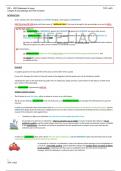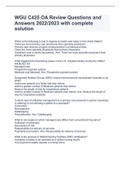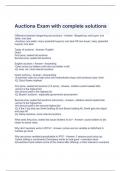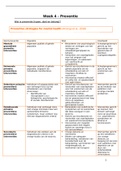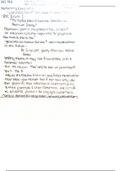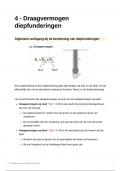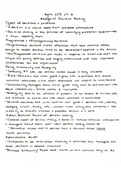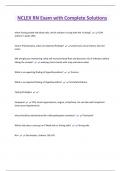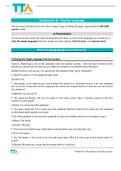DR – WS3 Statement of case TIFF LIAO
Chapter 8 proceedings and Part 8 Claims
INTRODUCTION
- So far, looked at the rules relating to a CLAIMANT bringing a claim against a DEFENDANT.
- PART 20 of the CPR 1998 deals with other types of “additional claims” that may be brought in the proceedings as set out in R20.2:
(1) This Part applies to—
(a) a counterclaim by a DEFENDANT against the CLAIMANT OR against the CLAIMANT and some other person;
(b) an additional claim by a DEFENDANT against any person (whether or not already a party) for contribution or
indemnity or some other remedy; AND
(c) where an additional claim has been made against a person who is not already a party, any additional claim made by
that person against any other person (whether or not already a party).
(2) In these Rules—
(a) ‘additional claim’ means any claim OTHER THAN the claim by the claimant against the defendant; and
(b) UNLESS the context requires otherwise, references to a claimant or defendant include a party bringing or defending
an additional claim.
EXAMPLE
A supplies goods to B. B has paid 50% of the price, but the other 50% is unpaid.
B sues A for damages for breach of contract based on the allegation that the goods were not of satisfactory quality.
A defends the claim on the basis that the goods were of satisfactory quality and also counterclaims for the balance of 50% of the
price which is still outstanding.
This counterclaim is governed by PART 20.
Another common scenario
- The D wishes to pass the blame, either in whole or in part, on to a third party.
- The D may be seeking a full indemnity from the third party, or a contribution towards any damages the defendant has to pay the
claimant.
A claim for an indemnity often arises where there is a contractual relationship between the defendant and the third party, and the
DEFENDANT alleges that the third party is obliged by the terms of the contract to indemnify the defendant if they are found liable in
respect of the claimant’s claim against them.
o Sometimes a right to an indemnity may arise from statute or by implication of law.
An example of a claim for an indemnity is where a consumer sues a retailer in respect of goods they allege are not of
satisfactory quality, and the retailer alleges that there was an inherent defect in the goods and attempts to pass on liability
to the manufacturer. The retailer will claim an indemnity from the manufacturer in respect of any sums that they are
ordered to pay to the consumer.
A claim for a contribution often arises where there are joint wrong-doers, and the DEFENDANT claims that the third party is partly
responsible for the harm that the claimant has suffered.
An example of a claim for a contribution is where the claimant claims damages from the defendant as
a result of a road traffic accident, and the defendant alleges that another driver was partly to blame
for the accident. A defendant will then claim a contribution from the other driver towards the
damages which the defendant is ordered to pay to the claimant.
1
TIFF LIAO
, DR – WS3 Statement of case TIFF LIAO
Chapter 8 proceedings and Part 8 Claims
8.2 PROCEDURE
COUNTERCLAIMS RULE not part of prep reading
20.4
- If one DEFENDANT wishes to seek a contribution or an indemnity from another party, AFTER filing
their acknowledgement of service or defence, they may proceed with their claim against that party
by:
(a) Filing a notice containing a statement of the nature and grounds of their additional
claim; AND
(b) Serving the notice on that party.
CONTRIBUTION OR - NO permission is required if:
INDEMNITY BETWEEN P the DEFENDANT files + serves the notice with the defence; OR
PARTIES P the party against whom the claim is made is added later, within 28 days of the parts filing
their defence.
RULE 20.6
- Permission IS required to file + serve the notice at all other times.
IF:
(a) claim form is issued by a CLAIMANT against more than one defendant but NOT served on one of
the defendants, AND
(b) time for service of the claim expired without service on that defendant.
= a DEFENDANT who is served HAD TO use CPR, r.20.7 if they wish to commence an additional
claim against the non-served defendant.
(Bailey v Barclays Bank UK Public Ltd Co [2021] EWHC 3698 (QB)).
OTHER ADDITIONAL not part of prep reading
CLAIMS RULE 20.7
8.3 DRAFTING A COUNTERCLAIM
- A defence AND a counter claim.
- Set out in a single document – PD20,para 6.1
DEFENCE AND - The title to the action remains the Usame.
COUNTERCLAIM
- The document should be entitled ‘DEFENCE AND COUNTERCLAIM’.
- The document itself is sub-divided into 2 sections - normally by centred sub-headings of
‘DEFENCE’ - at the start and then.
‘COUNTERCLAIM’ – immediately after the defence ends.
- This is one continuous document.
- The paragraph numbering therefore runs sequentially from the start of the defence through to the end
PARAGRAPH of the counterclaim.
NUMBERING
- The wording of any summary at the end should be, ‘AND THE DEFENDANT COUNTERCLAIMS’.
- Defence and counterclaim essentially the SAME as a separate defence and particulars of claim.
- Counterclaim = self-standing claim (akin to particulars to claim)
Must deal with all the material facts AND particulars the establish the claim.
DRAFTING SKILLS If facts that are material to the counterclaim have already been set out/admitted in = cross-refer to
the relevant paragraph(s) of the defence.
2
TIFF LIAO
Chapter 8 proceedings and Part 8 Claims
INTRODUCTION
- So far, looked at the rules relating to a CLAIMANT bringing a claim against a DEFENDANT.
- PART 20 of the CPR 1998 deals with other types of “additional claims” that may be brought in the proceedings as set out in R20.2:
(1) This Part applies to—
(a) a counterclaim by a DEFENDANT against the CLAIMANT OR against the CLAIMANT and some other person;
(b) an additional claim by a DEFENDANT against any person (whether or not already a party) for contribution or
indemnity or some other remedy; AND
(c) where an additional claim has been made against a person who is not already a party, any additional claim made by
that person against any other person (whether or not already a party).
(2) In these Rules—
(a) ‘additional claim’ means any claim OTHER THAN the claim by the claimant against the defendant; and
(b) UNLESS the context requires otherwise, references to a claimant or defendant include a party bringing or defending
an additional claim.
EXAMPLE
A supplies goods to B. B has paid 50% of the price, but the other 50% is unpaid.
B sues A for damages for breach of contract based on the allegation that the goods were not of satisfactory quality.
A defends the claim on the basis that the goods were of satisfactory quality and also counterclaims for the balance of 50% of the
price which is still outstanding.
This counterclaim is governed by PART 20.
Another common scenario
- The D wishes to pass the blame, either in whole or in part, on to a third party.
- The D may be seeking a full indemnity from the third party, or a contribution towards any damages the defendant has to pay the
claimant.
A claim for an indemnity often arises where there is a contractual relationship between the defendant and the third party, and the
DEFENDANT alleges that the third party is obliged by the terms of the contract to indemnify the defendant if they are found liable in
respect of the claimant’s claim against them.
o Sometimes a right to an indemnity may arise from statute or by implication of law.
An example of a claim for an indemnity is where a consumer sues a retailer in respect of goods they allege are not of
satisfactory quality, and the retailer alleges that there was an inherent defect in the goods and attempts to pass on liability
to the manufacturer. The retailer will claim an indemnity from the manufacturer in respect of any sums that they are
ordered to pay to the consumer.
A claim for a contribution often arises where there are joint wrong-doers, and the DEFENDANT claims that the third party is partly
responsible for the harm that the claimant has suffered.
An example of a claim for a contribution is where the claimant claims damages from the defendant as
a result of a road traffic accident, and the defendant alleges that another driver was partly to blame
for the accident. A defendant will then claim a contribution from the other driver towards the
damages which the defendant is ordered to pay to the claimant.
1
TIFF LIAO
, DR – WS3 Statement of case TIFF LIAO
Chapter 8 proceedings and Part 8 Claims
8.2 PROCEDURE
COUNTERCLAIMS RULE not part of prep reading
20.4
- If one DEFENDANT wishes to seek a contribution or an indemnity from another party, AFTER filing
their acknowledgement of service or defence, they may proceed with their claim against that party
by:
(a) Filing a notice containing a statement of the nature and grounds of their additional
claim; AND
(b) Serving the notice on that party.
CONTRIBUTION OR - NO permission is required if:
INDEMNITY BETWEEN P the DEFENDANT files + serves the notice with the defence; OR
PARTIES P the party against whom the claim is made is added later, within 28 days of the parts filing
their defence.
RULE 20.6
- Permission IS required to file + serve the notice at all other times.
IF:
(a) claim form is issued by a CLAIMANT against more than one defendant but NOT served on one of
the defendants, AND
(b) time for service of the claim expired without service on that defendant.
= a DEFENDANT who is served HAD TO use CPR, r.20.7 if they wish to commence an additional
claim against the non-served defendant.
(Bailey v Barclays Bank UK Public Ltd Co [2021] EWHC 3698 (QB)).
OTHER ADDITIONAL not part of prep reading
CLAIMS RULE 20.7
8.3 DRAFTING A COUNTERCLAIM
- A defence AND a counter claim.
- Set out in a single document – PD20,para 6.1
DEFENCE AND - The title to the action remains the Usame.
COUNTERCLAIM
- The document should be entitled ‘DEFENCE AND COUNTERCLAIM’.
- The document itself is sub-divided into 2 sections - normally by centred sub-headings of
‘DEFENCE’ - at the start and then.
‘COUNTERCLAIM’ – immediately after the defence ends.
- This is one continuous document.
- The paragraph numbering therefore runs sequentially from the start of the defence through to the end
PARAGRAPH of the counterclaim.
NUMBERING
- The wording of any summary at the end should be, ‘AND THE DEFENDANT COUNTERCLAIMS’.
- Defence and counterclaim essentially the SAME as a separate defence and particulars of claim.
- Counterclaim = self-standing claim (akin to particulars to claim)
Must deal with all the material facts AND particulars the establish the claim.
DRAFTING SKILLS If facts that are material to the counterclaim have already been set out/admitted in = cross-refer to
the relevant paragraph(s) of the defence.
2
TIFF LIAO

